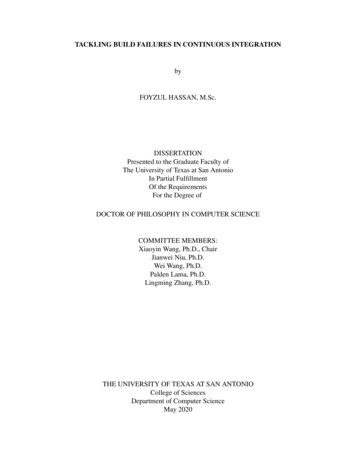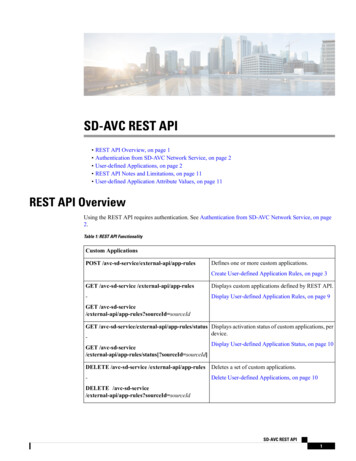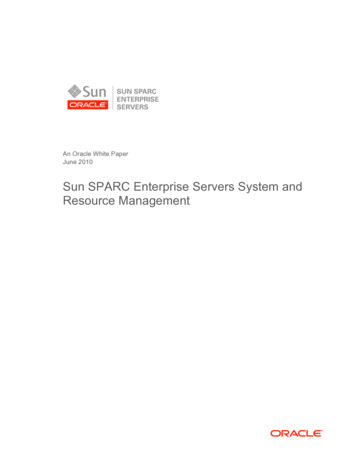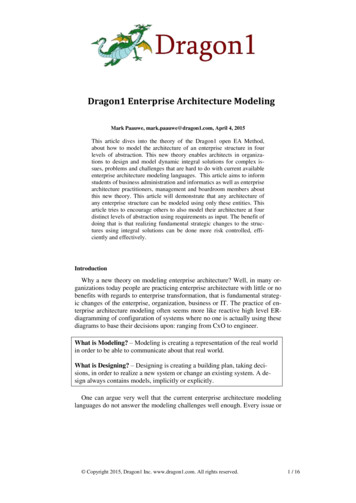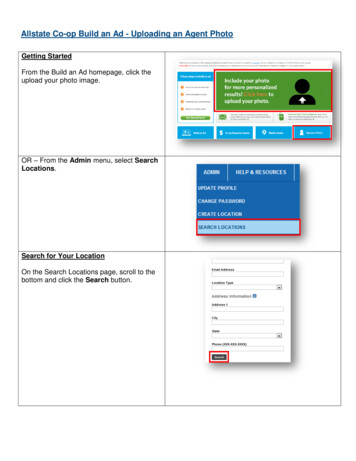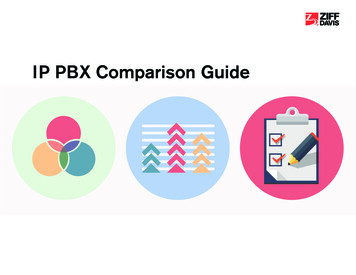
Transcription
How to Build anEnterprise-GradeMarketingTaxonomy
When a large organization gets ready to launch anew marketing campaign, there’s a great deal ofvision, work, and planning involved in bringing itto fruition.It needs to be able to send a unified message acrossdifferent departments, through different channelsand to different consumers seamlessly.Simply put, there are a lot of moving parts.This process requires a lot of data. In order for that data to work, it needsa framework or a structure to follow. This framework is known as amarketing taxonomy.Think back to your days in the school library.When you needed to find a book, you didn’t just roam the shelves hopingyou would find what you needed. You used a system, the Dewey DecimalSystem, to find the specific title you were looking for.The library would classify books into different sets in order to make themeasier to find and access. Sometimes these categories overlap, sometimes books are filtered into different categories, but the system provides the structure necessary to make the library more efficient.This is what a unified taxonomy can do for your business. It will notonly keep your marketing concepts and data organized, but it will optimize your company’s results. Many of today’s top global brands rely onenterprise-grade marketing taxonomy. We know, because we work withthem to develop this system.And you don’t have to be a Fortune 500 company to implement thesame structure these brands rely on.Even if you aren’t a large global enterprise, developing an enterprisegrade marketing taxonomy is what will help you get the most out ofyour content. If you want a better experiences and a higher ROI fromyour marketing and advertising investment, the right taxonomy isessential—you just need to know how to build it.1
Metadata And Tracking Codes*:The Foundation for Your Marketing TaxonomyAs you start to look at the big picture of your marketingtaxonomy, you need to first understand the role played by metadata and tracking codes. They work with each other to create ta crucial framework. While equally important, they have two very different roles in your taxonomy initiative.Metadata 101Before you can start building a marketing taxonomy, you need toidentify and understand your metadata. On a very basic level,metadata describes other data. It is essential to the taxonomyprocess because it labels information so that it can be sortedappropriately.EXPERIENCEWeb PageContentImagesMobile AppPEOPLETeamChannelGroupBusiness UnitAgencyRegionWHAT lacementNameAd GroupCategoryNameSKUObjective*We’re using standardizing your tracking codes as an example of how to use your marketing taxonomy.Similar rules apply when creating content, product catalogs, digital coupons and more.2
Metadata lives in nearly every component of an organization,which makes the task of implementing a standardized metadatalibrary one of the biggest obstacles most companies will facewhile building their taxonomy. There will be a lot of informationto organize.However, before you can dive into this process, it is importantto understand what exactly your metadata is so you have a betterunderstanding of its roles.Start by looking at the different areas of your organization thathouse metadata.Typically, this includes the following departments: Marketing Merchandising/inventory management Project management (i.e. Workfront) Creative/content management systems CRM systems Product management systemsThese areas typically represent the highest level in which metadatais defined. Once you identify these categories within your ownestablishment, you can start to understand the relationship betweenthem, so you can start to create a hierarchy.For example, the key from a product catalog may be the product ID.But is there a relationship between that value and a category key?Once you understand the hierarchy and relationship between yourmetadata datasets, or how you’re tying this data together, you candive into the individual sections to further understand what datais available.3
Key Components of Building Tracking CodeTracking codes are another key building block to your perfectenterprise-grade marketing taxonomy. Marketing campaigntracking codes collect data about a user’s online pattern ofbehavior. Tracking codes provide a key into a wealth of data andinsights that can be used to better understand the consumer.However, there are a lot of misconceptions about tracking codes,such as how they’re structured.Standardized vs. Consistent Tracking CodesWhen it comes to tracking codes, one of the most common termsyou will hear is standardization. After all, standardized trackingcodes are critical to data maturity. It also means you have a clearlydefined taxonomy that teams and partners should be following.You have created a standard for them to follow.Unfortunately, standardization is often confused with “consistency.”These are two very different terms. Tracking codes do not need tobe consistent to be effective. They just need to all meet the samestandard.It’s a common misconception that tracking code taxonomy needsto be consistent in order to have a mature, clean data model. If youare dependent on a consistent taxonomy structure to decode andparse out components of your system, then generate your metadata fields, it can prevent you from pivoting your data and viewingyour reports in a beneficial manner.That, by definition, is not a mature data structure. It is one that isprone to error.While you can strive to enforce consistency in the taxonomy, it isn’ta hard and fast rule. Consistency is nice and it makes your trackingcodes look pretty, but pretty doesn’t matter. What matters is thedata you get from those tracking codes.Sure, if you are planning on making sense of rows and rows oftracking codes, having them well-aligned and tied up in a nicelittle package would make things easier. But who wants to bedependent on looking at reports solely by tracking codes?4
For example, the following tracking codesare very clean, pretty, and well aligned:Email-2020 Blue Shoes-Eloqua-RetentionPaid Search-2020 Blue Shoes-Google-NurtureDisplay-2020 Pink Shorts-Google-ConversionSomething like the above example would be easy to parse out andanalyze. The problem with this: it doesn’t always make sense froma process standpoint. This is why holding on to the idea of these"consistent" tracking codes can sometimes do more harm than good.You need to be able to shift your way of thinking and focus on a standardized approach.Shifting Your Focus to Standardized Tracking CodesThe key to finding success with your tracking codes is to firstdetermine what it is that you are trying to achieve with yourtaxonomy. Ask yourself the following questions about what it isthat you are trying to achieve. Do we want to obfuscate my tracking codes to shorten ourURLs and avoid losing tracking? Have we run into issues where proprietary information hasbeen in the final URL that users see (like demographic or agetargeting)? Do we have limited visibility in reporting and a need toenrich our data? Do we want to help streamline the tagging workflow formarketers so they’re more keen to adopt and follow theestablished taxonomy?If you answered “yes” to any, or all, of these questions, then you don’tneed to be obsessing over consistency tracking code taxonomy. It’stime to shift your focus to standardized tracking codes instead. Whiletracking codes themselves are critical, it’s not necessary to have themappear exactly the same across all channels. This will only limit you.5
What Are the Critical Components of Tracking Codes?It isn’t necessary for tracking codes to be exactly the same in orderto be effective. Yet the term “consistent” is often thrown aroundwhen it come to tracking codes. Consistent does not meaneverything needs to be organized identically. Instead it is importantthat tracking codes are applied consistently, or applied using thesame standard. It’s also important that the data being associatedwith these tracking codes meets the same standard.What’s important is that tracking codes make sense. This is farmore important than having them all look the same. The goalshould be for these tracking codes to leverage the features ofvarious platforms together to help you achieve your goals.You shouldn’t go into this process thinking you need to fit a circlein a square. Tracking codes can still meet the same standards, yetlook inconsistent to meet their distinct environments.Consistency is also subjective. For example, astandard obfuscated tracking code taxonomy maylook something like this:Taxonomy: [channel code]-[country code]-[random number]-[random string]Sample Value: EM-US-74-LGYEGGSVAThis taxonomy will vary based on the channel. For example, the abovesample would be for email. However, that taxonomy will change slightlywhen used for Facebook campaigns, specifically to leverage Facebook’smacros. So, the same taxonomy for Facebook would look something like:Taxonomy: [channel code]-[country code]-[FB campaign ID]-[FB adset ID]-[FB ad ID]Sample Value: SOC-US-3465678-3894758-98748756
You can see the taxonomy for Facebook isn’t exactly the same as(consistent with) the taxonomy used for email, but it still has asimilar beginning and meets the same standard. In the end this isthe best way to leverage the data you have available, while makingthe marketer’s job easier.This example is a fairly standard tracking code. A lot of times, especially in Adobe Analytics, Marketing Channel Processing Rules areconfigured to look at the beginning of the tracking code to determine which channel to bucket a hit into. This is one of the mainreasons it is always smart to stick with the structure above.Establishing Your TaxonomyWhen establishing your taxonomy, you should always keep youroverall goals at the forefront of your decisions. Determine what youare trying to achieve and then focus on the technical impact.Are there dependencies in downstream reporting you need toconsider? What is the impact with that change? How do youplan to accommodate or remediate it?It’s OK if there is an impact, you just need to understand what thatimpact is and have a plan in place to remedy it. If it’s somethingthat you can fix by reclassifying your legacy data, then it is typicallythe right choice to try to remedy the situation instead of scrappingit all together.Once this is done, you can move forward withyour “global” tracking code taxonomy as the initialrecommendation:[channel code]-[country code]-[random number]-[random string]7
Then, after discovery sessions with the stakeholders, evaluate ifyou’re trying to fit a circle into a square or if this approach makessense (we will talk more about discovery sessions later). Determineif there are platform specific codes you can use as the obfuscatedportion. Would that make this more seamless or does a globalstructure work?It varies with each organization, with each channel, with eachteam, and with each platform. There is no silver bullet. You mustbe willing to have conversations after the initial proposal and workfrom there.8
Evaluating The Data YouWant to CaptureNow that you have determined what the taxonomy will look like,it’s time to evaluate the data you want to capture. This is themost time-consuming part of the process. Remember, to do thiseffectively, it should take time.Evaluating your data requires a lot of conversations, people, andopinions, but the outcome is worth it. You may already have anidea of what data you want to capture, but it’s important to get thenecessary teams involved from the start.Start with your initial list of the data fields you see as necessary andthen take the following steps to gather all the information requiredto make decisions about your metadata fields.Identify Key StakeholdersThe first step in making important decisions with your metadatafields is to identify the key stakeholders. Start by identifying whoowns each channel. Then identify if there is an external partner,such as an agency or a vendor, that manages that channel.Don’t forget about business intelligence (BI) teams. They’re oftenseparate from analytics but should be included as astakeholder in the conversations. While we typically think ofstakeholders as marketing channel owners, BI or reporting teamscan be impacted by a change in tracking code structure and theyshould be included in this process to help identify any areas ofconcern.You can determine this by asking internally, “do we have reportingoutside of our analytics environment (such as Tableau or Snowflake) that leverages data from our analytics platform?”If the answer is “yes,” you’ll want to schedule a discoverysession with the team that owns that process to discuss theirrequirements and the proposed changes to the data fields andtaxonomy. Worry not, it can all be seamlessly connected.9
Schedule Discovery SessionsThe next step in the process is to schedule discovery sessions tostart getting a feel for what it is you want to capture in yourtaxonomy. The discovery session is all about asking the rightquestions and getting the answers you need to move forward.These questions include the following1. What platforms are you using?2. Are there platform requirements for the tracking codes?3. What is the current workflow?4. What is the current taxonomy?5. What fields do you currently capture?6. What fields do you want to capture?7. What dimensions do you currently report on?8. What dimensions do you wish you could report on?9. Is there a reporting dependency we’re unaware of?(i.e. is the agency providing any reporting that isdependent on the tracking code structure?)The more detailed and honest about your answers, the better yourresults will be. The more information you can gather in these initialsessions, the more helpful they will be down the line.Define Core Business FieldsAfter you host discovery sessions with the various stakeholders, takeall of the information you’ve gathered and draw parallels between thechannels to try and find any areas of consistency.10
Consider this example:If the Email Campaign Name is being captured by the Email Team andGoogle Campaign Name is being captured by the Display Team, youhave an opportunity to combine these in one field called “PlatformCampaign Name.”However, with this example there will likely be inconsistencies based onhow different teams decide to name their campaigns.There are two solution to navigating this issueand defining the core business fields.Option 1Option 2Create a core field called “BusinessCampaign Name” which is a set,universal picklist of the business-defined campaign names.This list could be generated fromyour project management tool (i.e.Workfront) or something the analytics team manages on an ongoing basis.Make “Platform CampaignName” a concatenated fieldwhere it gets created as the usersare inputting values to generatethe tracking code. This tacticcreates consistency in thenaming convention. However,you will not get the level of consistency you would with Option 1.The goal here is to create consistency so that in your reporting, you canpull a report for 2020 Q1 Retentionand break out performance byevery channel seamlessly.This part of the process is whereyou ask yourself, what type ofreports do I get asked for/whatviews do I get asked for mostfrequently?Some businesses find high value in pulling reports based on overarchingcampaigns, others find value in pulling them by budget allocation (i.e.regional versus global).11
Once you’ve identified all of the parallels, the remaining fields aretruly channel specific. For example, “Link ID” is a common field foremail tracking that is not something found in other channels.“Keyword” is something that is relevant for paid search, but notother channels.It’s OK to have channel-specific fields, it’s inevitable. Channelspecific fields simply mean that when you want to pull a report,you don’t need to see a report for that specific field across variouschannels. You would use those fields to analyze and optimizewithin a channel.Create a “Data Dictionary”Once you’ve determined the core business fields and the channelspecific fields, it’s time to create a data dictionary. This can bean Excel or a Google Sheet. The goal here is to get the outlineestablished to then review with the teams.Here’s a simple way to organize it:1In the left-most column, list out your different channels.2In the headers of the subsequent columns, list out the core business fields.3Under each header, fill out what the input values are by channel.Once you’ve filled out the input values for the core fields by channel, make anote of the channel-specific fields and their associated input values.12
Reviewing and Presenting Your Data DictionaryOnce you have your data dictionary it’s time to review your proposed new outline with your various teams. The goal is toalign on input values. You want to make sure that the values arerelevant to each of the teams while identifying if any values canbe preset or filtered.This will be a more collaborative process that will hopefully helpclean up and narrow down your proposed data outline into asolution that works for everyone.Implementing Your New TaxonomyOnce your different teams have signed off on your proposedoutline, it’s time to implement your new taxonomy. Create atracking code builder template for each team. This is typically abetter approach than creating a master taxonomy documentbecause you can customize it to meet every team‘s needs.For example, for the social taxonomy template publishers,the available input values would only be social media platformsrather than having a long list of all possible input values regardlessof channel. This will help keep things more organized foreveryone involved.LaunchWhile it takes a great deal of time and effort to get to this point,it’s now time to deploy your taxonomy!However, that doesn’t mean your work is over.13
Marketing Taxonomy Checklist1. Identify Key Stakeholders2. Schedule Discovery Sessions3. Define Core Business Fields4. Create a Data Dictionary5. Review and Present Your Data Dictionary6. Implement Your New Taxonomy7. Launch14
Considerations For Your NewMarketing TaxonomyWhile your new marketing taxonomy may be up and running,there are still a few considerations to keep in mind. And you mayneed to tweak or adjust the taxonomy to fit your company’sunique and evolving situation.Legacy DataMany times, when you’re revamping your tracking code taxonomyand metadata fields, there’s concern around the transition.You’re moving away from the legacy tracking codes that areinconsistent, nearly impossible to decode, and that have little to nometadata. Instead, you’re relying on a newly standardized trackingcode with a wealth of metadata.Some organizations choose to cut their losses and take the “outwith the old, in with the new” approach, while others do not havethat luxury. Many times, they’re instead dependent onyear-over-year reporting. In these situations, it may be best tore-classify legacy data and make the following decisions. Do you keep the legacy tracking codes on anythingin-market and anything new you “launch” will use the newtaxonomy? Do you re-classify all in-market tracking codes ANDupdate in-market campaigns with the new trackingcodes?If you chose to reclassify legacy data, you will need to partner withall of the channel stakeholders to pull the legacy tracking codesand define their values for the new metadata fields. Lean on yourpartners or agencies to decode the tracking codes. After all, they’rethe ones that launched the campaigns and defined that previoustaxonomy, meaning they should be able to decode it.15
Analytics and Report ImplicationsMake sure to ask yourself the following questions about your analyticalimplications once your taxonomy has launched: Are there rules/logic configured in my web analytics platform that is dependent on the taxonomy? Are there segments configured to be dependent on thetaxonomy or data fields? Are there reports that are configured to bee dependent onmy data fields/taxonomy?You should also ask yourself if there are any reports that areconfigured to be dependent on your data fields or taxonomy.These could be internal reports in data platforms like Power BI,Tableau, Snowflake, or external reports from vendors/agencies.This is an important consideration while moving forward with yournew taxonomy.Remember, there are a lot of considerations youwill need to make when building a taxonomy thatsuits your organization best.Even once you’ve launched, tweaks, changes, orre-classifications may be necessary in order tokeep your system as efficient as possible.16
Claravine is a leading data integrity platformthat helps standardize, govern, and connectdata across every team, system, and channel.Top global brands use Claravine to centralizecontent and campaign data structures whilegoverning the process of generating, validating,and connecting data. This supercharges datastrategies for optimal digital experiences acrossenterprise and customer touchpoints.The benefits are richer insights, experiences,and ROI from marketing, content, analytics, andadvertising investments.www.claravine.com(385) 286-0800
enterprise-grade marketing taxonomy. We know, because we work with . the taxonomy used for email, but it still has a similar beginning and meets the same standard. In the end this is the best way to leverage the data you have available, while making the marketer's job easier. This example is a fairly standard tracking code. A lot of times .

